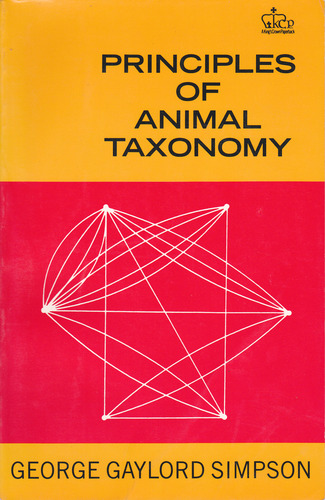Principles of animal taxonomy download
Par rolland michael le lundi, février 15 2016, 23:43 - Lien permanent
Principles of animal taxonomy by George Gaylord Simpson


Principles of animal taxonomy George Gaylord Simpson ebook
Page: 131
Format: djvu
ISBN: 023109650X, 9780231096508
Publisher: Columbia University Press
Andrew Pawley (Aukland, 1991), 137-47; Brent Berlin, Ethnobiological Classification: Principles of Categorization of Plants and Animals in Traditional Societies (Princeton, 1992); Douglas Medin and Scott Atran, eds. With Darwin's theory, a general acceptance that classification should reflect the Darwinian principle of common descent quickly appeared. Exclusive excerpt from Lord Robert May's book, Theoretical Ecology: Principles and Applications, published by Oxford University Press, 2007. Excerpt from Theoretical Ecology: Principles and Applications. Simpson GG (1961) Principles of Animal Taxonomy. The principles of naming new species of animals may seem like tedious legal work, but it can be fun—and sometimes you get to honor people as well with a new species named after them. Cuvier's The Animal Kingdom, Arranged According to its Organization, Serving as a Foundation for the Natural History of Animals, was an attempt to classify the animal kingdom on the basis of comparative anatomy, of which Cuvier's entire classification schema was Using these principles, Cuvier established a taxonomic approach based on comparative anatomy that established correlations between the inner systems that maintained life within an organism. He studied botany and medicine and Of his higher groupings, only those for animals are still in use, and the groupings themselves have been significantly changed since their conception, as have the principles behind them. By method authors mean an arrangement of minerals, plants, and animals according to the principles of logical division. The principle behind the method is illustrated in Figure 1, which shows a single species splitting into two independently evolving populations that gradually diverge over time. Linnaeus, Carolus (kärō'ləs lĭnā'əs), 1707-78, Swedish botanist and taxonomist, considered the founder of the binomial system of nomenclature and the originator of modern scientific classification of plants and animals. Tree of Life representations became popular in scientific works, with known fossil groups incorporated. The end result was a classification of existing 'data assets' into three main types of animals (although I would later argue the animals were really different zoos.) From this I During the UX design a fundamental principle was data integrity.